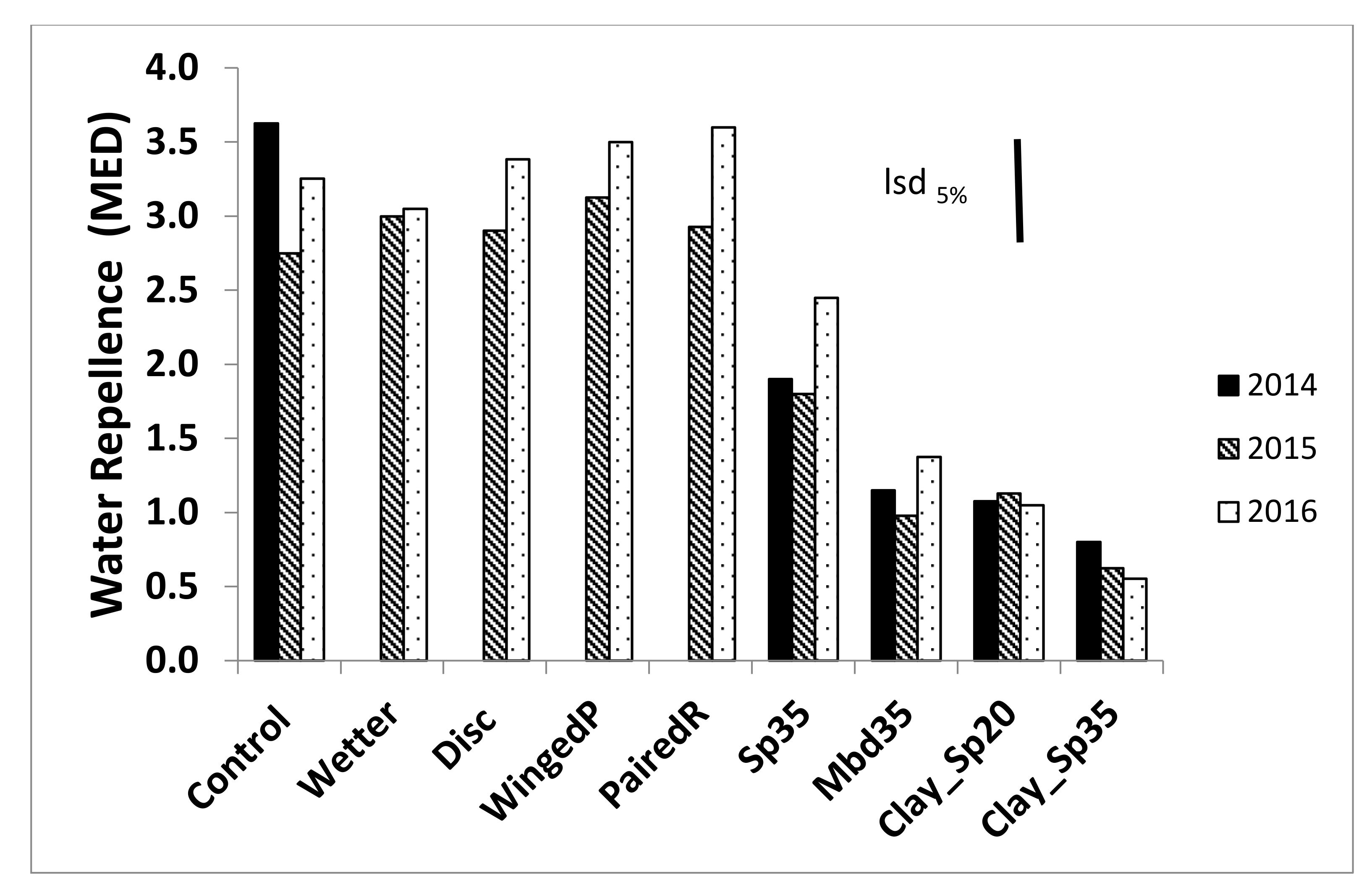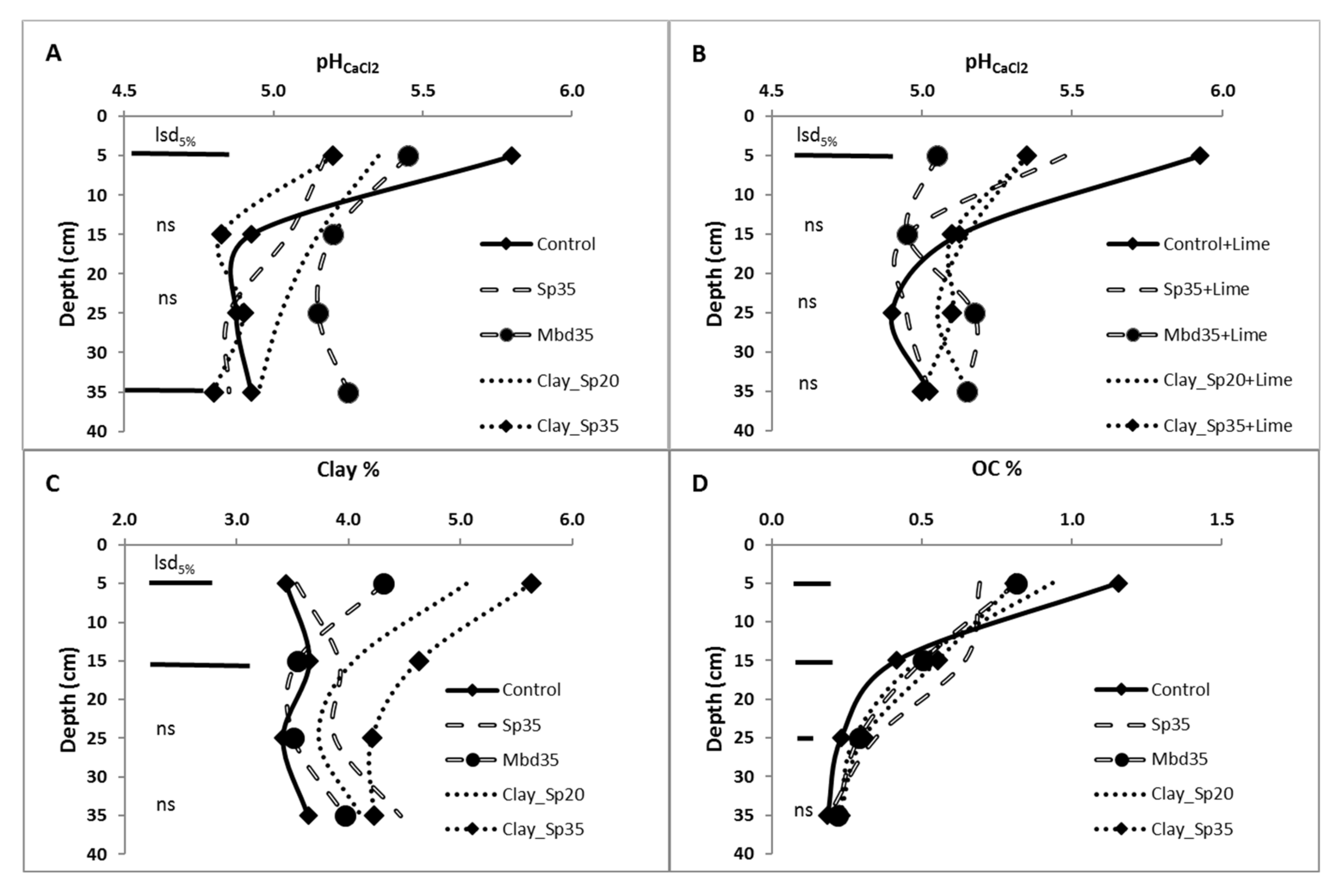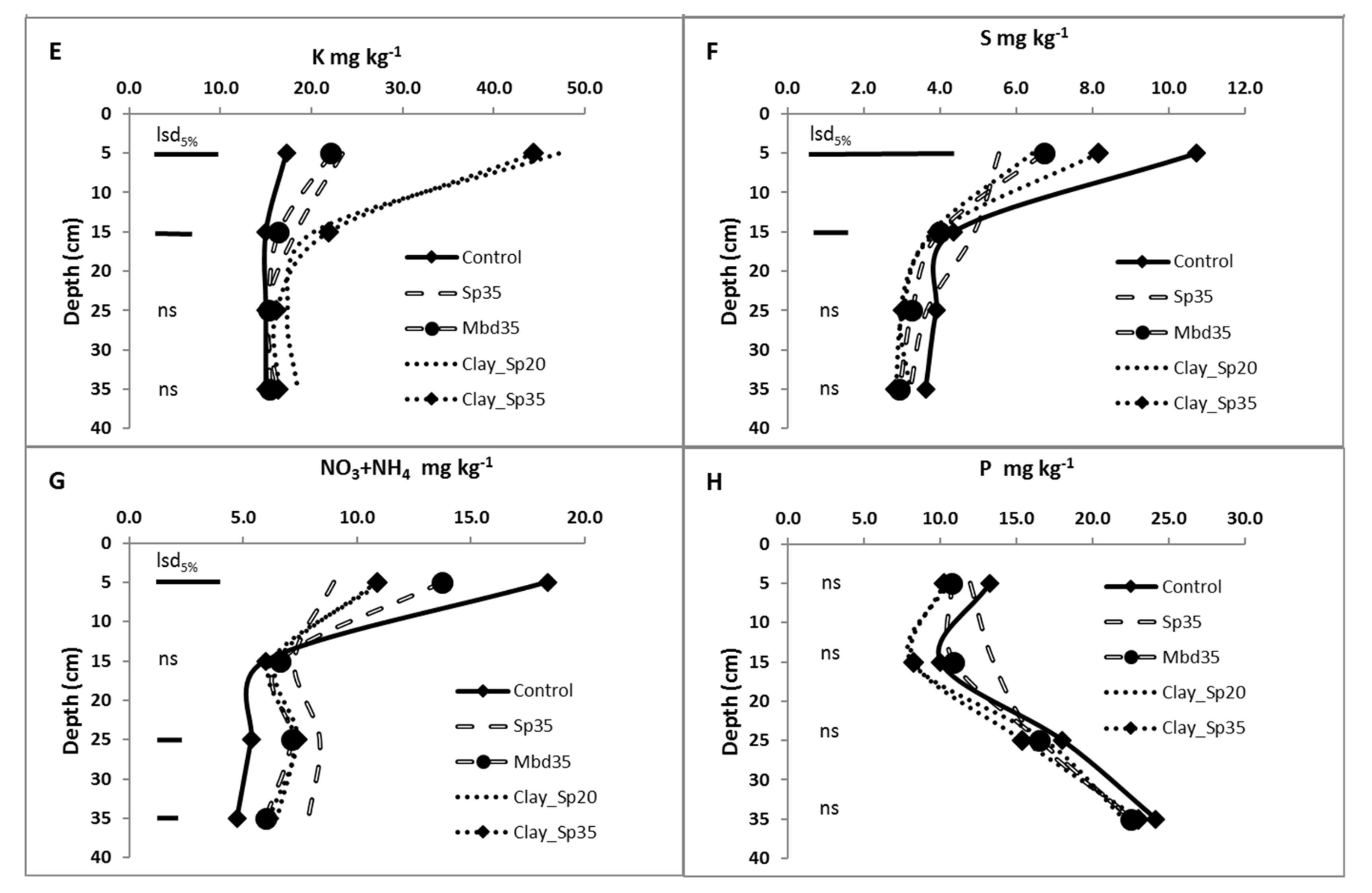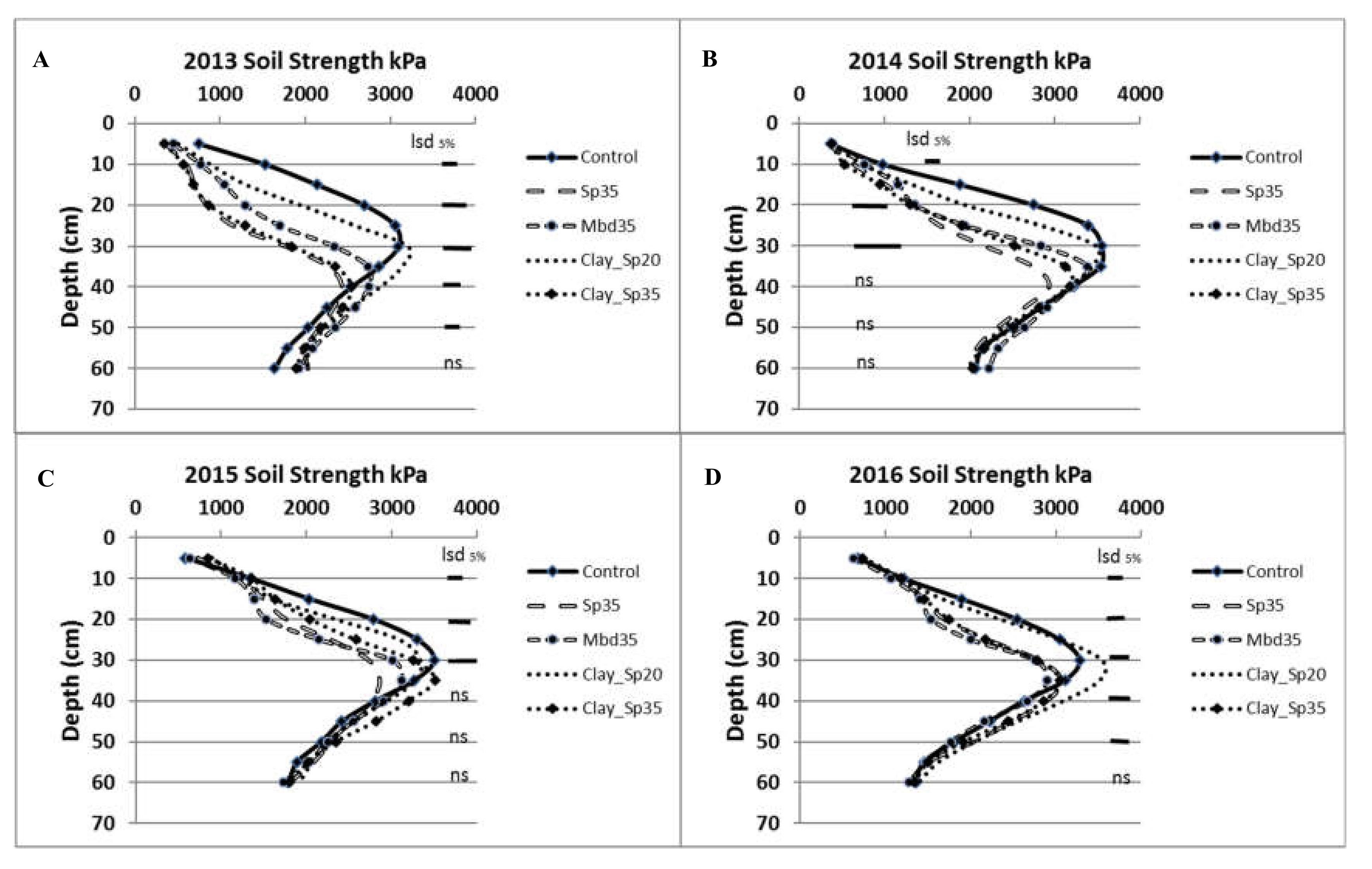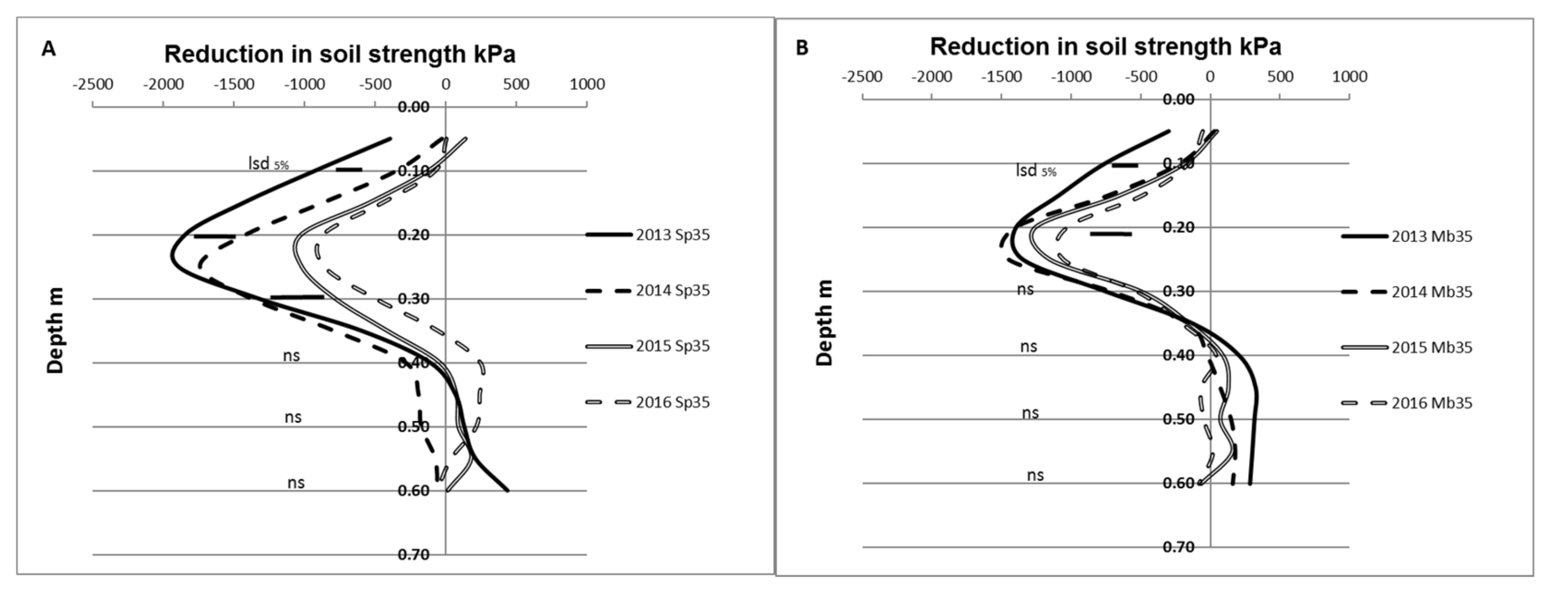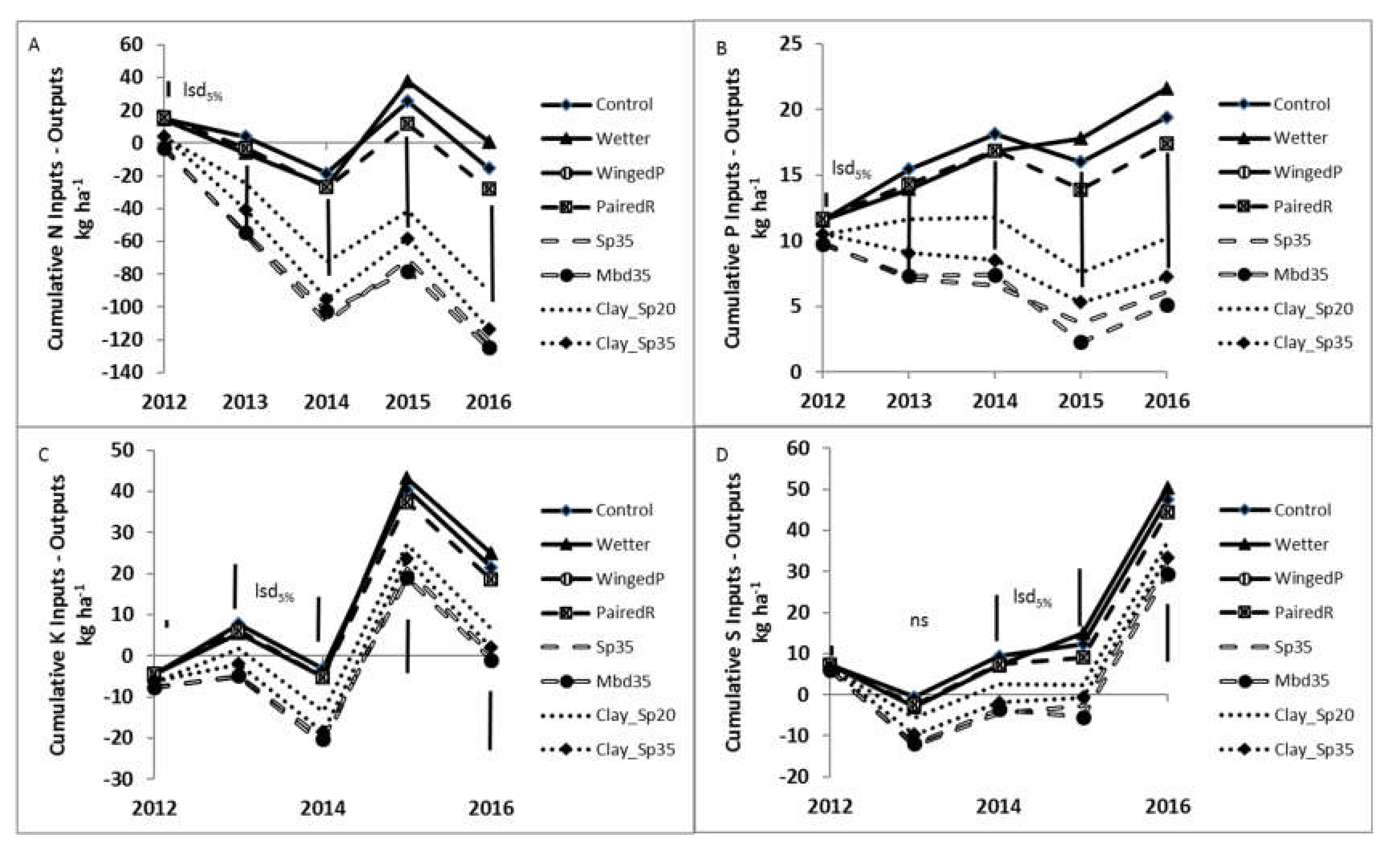1. Introduction
Approximately 900,000 km
2 or 5% of soils used for crop production globally have a deep sand profile [
1]. The proportion of cropping soils with sand subsoil is greatest in Africa and Australia-Oceania. A characteristic of deep sands is that they present multiple constraints to crop production, mostly related to their limited capacity to store and supply water and nutrients to roots. The Deep sands (>0.3 m) cover approximately 40% (7 Million ha) of the Western Australia (WA) wheatbelt and are predominately used for dryland crop and volunteer pasture production. These soils are subject to a number of constraints to crop production [
2] which relate to their parent material, texture and soil forming processes. The south coast sandplain soils are derived from Precambrian granites which have undergone marine incursions during the Eocene and the deposition of aeolian sand sheets during the Quaternary epoch [
3]. The multiple constraints on these sands include acidity (pHCaCl
2 < 5.5), low cation exchange (<4 cmol (+) kg
−1), low pH buffering capacity and inherently low levels of macro and micro nutrients [
4]. Given their aeolian genesis, the sandplain soils contain a sufficiently wide particle size distribution within the sand fractions to allow dense packing [
5,
6]. The ability to pack densely is exacerbated through natural and induced compactive forces including wetting and drying cycles [
7] and trafficking by machinery [
8,
9]. Water repellence is common in sandplain soils of WA due to the topsoils having a low proportion of clay (<5%) combined with naturally occurring organic waxes and polymers [
10]. Consequently, the sandplain soils on the south coast of WA are prone to multiple soil constraints for dryland crop production including compaction, water repellence, nutrient deficiencies and subsoil acidity [
2,
11,
12].
Where there are multiple limitations, the process of soil amelioration often seeks to sequentially overcome constraints starting with the most yield-limiting one. Pale deep sands ([
13], Albic Arenosols) and sandy earths ([
13], Ferralic Cambisols) in WA are considered to be highly responsive soils to deep tillage [
14]. Mean increases in cereal crop yields of 15–89% have been achieved as a result of deep ripping (subsoiling) sandplain soils in WA [
15,
16,
17] which is consistent with the magnitude of cereal crop responses to deep ripping measured on similar soil types in overseas studies [
18,
19]. Similarly average yield increases, in the order of 16–50%, have been found where water repellence has been alleviated through the addition of subsoil clays [
17], furrow sowing [
20], sowing back onto or near previous seeding lines [
10,
21], dilution and burial of water repellent topsoils through strategic inversion tillage [
22,
23,
24] and the addition of soil wetting agents [
20,
25].
However, where there are multiple limiting factors of a similar yield-limiting magnitude the gains from ameliorating one factor will be small relative to the gains where multiple constraints are ameliorated together [
26]. For instance, ameliorating water repellence alone through the addition of clay, while increasing grain yields by more than 30% still resulted in crops yielding substantially below their calculated water-limited yield potential [
27]. Strategic inversion and deep mixing of water repellent topsoils through mouldboard or one-way disc ploughing and rotary spading have been shown to be highly effective in reducing water repellence in Western and South Australian soils [
23,
28]. This process, which is termed strategic tillage [
24,
29,
30,
31], is a single or occasional use of tillage within what is otherwise a conservation agriculture farming system encompassing minimum tillage seeding and stubble retention. Strategic tillage potentially removes multiple soil, pest and weed limitations in a single operation with improvements in crop yields persisting for several years [
23,
30,
32]. Strategic tillage can take the form of shallow or deep cultivation [
23,
32,
33] depending on the soil type and nature of the constraints being addressed. Strategic deep soil mixing or inversion will de-compact the soil and incorporate soil amendments such as lime to working depth of the implement [
24]. The aim of this paper is to assess combinations of treatments including claying, liming and strategic deep tillage that alleviate multiple and single soil constraints including water repellence, subsoil compaction, acidity, and nutrient deficiencies on a common sandplain soil on the south coast of WA and to evaluate their effects on crop productivity over 5 successive cropping seasons.
4. Discussions
The treatments selected were chosen primarily to alleviate water repellence which is prevalent on sandplain soils on the southern coast of WA. However, the expression of water repellence was mostly limited to 2014 and 2015 when there was lower than average annual rainfall (Decile 2 and 4), while the largest crop yield responses were to treatments that alleviated other limiting factors, compaction and K deficiency. On soils with multiple limitations, treatments which are able to alleviate all or part of each constraint will achieve the greatest productivity increase. However, when such treatments (e.g., clay addition), are expensive, they may not achieve a profitable response even within 5 years.
Water repellence develops on sandplain soils within the organically stained topsoil, but the degree of water repellence declines with depth to the extent that the subsoils are not water repellent. Diluting and burying the water repellent layer by mixing the top and subsoils using a spading machine or inverting the water repellent topsoils through mouldboard ploughing were effective in ameliorating water repellence as has been reported on a range of other sandy soils in WA [
23,
28]. The results presented here suggest that mouldboard ploughing, spading and the addition of clay rich subsoil had the largest effects on reducing water repellence when compared to the wetting agent and to seeding tynes with minimal to substantial soil disturbance. In this experiment, water repellence was not affected by the addition of lime. Elsewhere the addition of lime at rates of 5, 10 and 15 t ha
−1 to water repellent sandplain soils with a lower topsoil pH
CaCl2 of 4.9 has resulted in a significant reduction in MED values and a tenfold increase in the populations of wax degrading organisms [
50].
Despite ploughing to 0.35 m, most of the changes in soil chemical properties occurred at depths less than 0.25 m. The distribution of clay in the profile was not affected by the different depths of spading with no changes in clay content below 0.15 m regardless of whether the soil was spaded to 0.20 or 0.35 m. This result is supported by [
24] who found that the majority of the topsoil remained within the 0–0.15 m layer following spading to a depth of 0.25 m. The mouldboard ploughed treatment resulted in less mixing and greater burial of the topsoil given the lower organic carbon levels at the surface and higher organic carbon levels at 0.25 m than the spaded soils. This suggests that mouldboard ploughing is likely to be more effective in incorporating ameliorants to depth but is less likely to evenly distribute ameliorants when compared to spading. In soils with lower subsoil pH than the present site, the more effective incorporation of lime at 0–0.3 m depth should have significant benefits [
51].
The addition and incorporation of clay-rich subsoils into sands has been shown to increase organic carbon, K and pH after 10 years in a field experiment on a similar sandplain soil to the present study [
17] and reduced nitrate leaching in a pot experiment on sandy soil [
52]. The increases in organic carbon are attributed to reduced microbial activity associated with clay addition [
53] and increased biomass production [
54]. However, no significant increases in organic carbon, mineral nitrogen or soil pH were found in this experiment after 5 years. Enhanced soil mixing associated with spading and the slow rates of carbon accumulation [
55] in sands may explain this.
In each year of the experiment, cereal and canola plant establishment were adequate to achieve rainfall limited yield potential. Relationships between canola establishment and final yield have shown that 30–40 plants m
−2 (mean 32) is near the optimum to reach yield potential across a range of environments within WA [
56]. The optimum plant density for wheat and barley can vary between 100 and 200 plants m
−2 [
57]. However, in WA, where the growing season rainfall is greater than 161 mm the optimal wheat density was 124 plants m
−2 [
58]. Overall crop establishment across all treatments was sufficient to achieve more than 85% of yield potential. The adequacy of plant establishment given the high MED values is attributed to two factors: favorable rainfall at seeding in most years and; seeds sown into the same rows for all crops in all years using ±0.02 m real time kinetic (RTK) guidance. On-row seeding has been shown to improve crop establishment in water repellent sands [
10,
59]. The poor relationships found between plant density at emergence and grain yield are further evidence of the adequacy of the established plant populations. Significant increases in plant densities were found in the majority of treatments only in the years (2014 and 2015) with below average rainfall. Canola emergence was found to be negatively affected by mouldboard ploughing in 2013. The reduction in canola emergence within the first few years of mouldboard ploughing has also been observed in commercial canola crops. The reason for the poor emergence is currently being investigated with some evidence of increased herbicide activity that damages the crop in mouldboard ploughed soils associated with reduced topsoil organic matter [
22,
60,
61]. In this experiment there was no consistent evidence to show that the knife point seeding boots were any less effective than the winged point or paired row seeding systems. Previous research has shown that knife point seeding tynes can exacerbate water repellence where the topsoil falls in behind the seeding tyne resulting in the seed being sown into a seam of water repellent soil [
10,
46].
The wetting agent and seeding tynes (WingedP, PairedR) did not significantly increase grain yields compared to the control in any year or in total. [
25] summarized experimental data comparing grain responses to winged points, paired rows and wetting agents using data from experimental sites from the northern to southern wheatbelt. They found that the average grain yield increases attributed to winged points, paired rows and banded wetting agents were 6% (range −2 to 14%,
n = 7), 19% (range 3 to 76%,
n = 5) and 10% (range −32 to 32%,
n = 19), respectively. The high degree of variability in grain yield response to banded soil wetting agents was further examined in a more recent review of changes in crop yield following implementation of strategies to manage soil water repellence [
47]. This demonstrated that crop yield responses to banded wetting agents occurred when the crop was sown into dry repellent soils with negligible responses when the soil was wet. Cereal grain yield response to wetting agents was also related to soil type with an average 21% (
n = 8, range 3–38%) yield increase with dry sowing on loamy gravel ([
13], Ferralic Retisol) and duplex sandy gravel soils ([
13], Abruptic Plinthosol), and 88% of comparisons showing statistically positive yield response. By comparison on deep sands ([
13], Arenosols), the grain yield response to banded soil wetters on dry sown cereals averaged 12% (
n = 6, range −13–32%) with only one-third of these comparisons having a statistically positive response [
47]. In this experiment, the lack of response to soil wetting agents could largely be explained by the wet conditions at seeding in most seasons and a soil type that is typically less responsive to soil wetting agents.
Crop yields were increased as a result of the spaded, mouldboarded and clayed treatments by 19 to 23% when averaged over all years. Grain yield increases associated with spading and mouldboard ploughing have been consistently reported across a range of environments in Western and South Australia following many years of no-till crop establishment [
23,
62,
63,
64]. On average crop grain yields were found to increase by 51% (range −2 to 150%,
n = 19) and 39% (range 0 to 100%,
n = 11) for the mouldboarded and spaded treatments, respectively, in WA [
65]. Results from a smaller number of South Australian studies [
64] suggest even higher yields from spading with average grain yield increases of 111% (range 63 to 200%,
n = 3). While spading was introduced to incorporate clay rich subsoils more effectively to remediate water repellence [
28], the crop yield responses suggest that in the short term spading alone is as effective as spading clay-rich subsoil. Crop yield results from other experiments support this with no significant differences in grain yields found at three South Australian sites [
64] and three sites in WA [
65,
66]. We therefore conclude that diluting the water repellent topsoil with the wettable subsoil is as effective as claying in the short term and in the absence of nutrient deficiencies. This is particularly evident in sands where there is a gradational increase in clay content with depth and where inversion tillage results in an increase in topsoil clay content.
The application of lime had no appreciable effect on crop emergence, grain yields or soil strength at this site. Apart from 2012, there were also no interactions between the lime and tillage treatments at this site. Soil pH exceeded pH
CaCl2 4.8 throughout the soil profile, a value that is used as a threshold beyond which aluminium is unlikely to be present in its toxic form [
67]. Hence there would be merit in follow-up studies on more acid soils with the lime treatment together with strategic deep tillage [
51] and claying treatments.
The increases in yield occurred independently of crop emergence in all years. This suggests that the limitations imposed by water repellence on seedling emergence are secondary to other soil constraints at this site. Nutrient concentrations in plant tissue for N, P, K, S, and B were marginal in most years (
Table 6). Mouldboard ploughing and spading (−clay), although creating greater uniformity of nutrients within the soil profile, did not have an appreciable effect on nutrient levels in plant shoots. The clayed treatments increased K and B and reduced Ca in plant shoots. Elevated K levels in clayed soils have previously been proposed as a mechanism for increased yields in sandplain soils [
17]. The increase in shoot K explained on average 19% (range 1–36%) of the variation in cereal and canola yields while effects from other nutrients were negligible. Elevated soil K levels can reduce Ca uptake [
68] which would explain the reduced Ca levels found in the clayed treatments in three of the five years. Nutrient balances indicate that N, P, K and S decreased and were at times negative for the higher yielding treatments. Nitrogen balances were mainly negative for all treatments apart from the Control. The partial N balance, however, does not take into account N mineralised from organic carbon, or losses due to leaching. Despite this, the balances do show the importance of matching nutrition to higher production levels in modified soils. Based on the plant shoot and nutrient balance data, the contribution of nutrition to increased crop yields as a result of spading, mouldboard ploughing and claying is not conclusive given that N, P and S plant shoot concentrations did not differ between the Control and the highest yielding treatments in most years. Furthermore, the treatments with the highest shoot K concentrations (Clay_Sp20, Clay_Sp35) did not yield significantly higher than the Mbd35 and Sp35 treatments in four of the five years.
Although the experiment was managed to suppress weeds in all years, mouldboard ploughing had less than half the weed populations in 2012 and 2013 compared to the control whereas the results for spading (±clay) were more variable. Reductions in weed populations of up to 95% have been found as a result of mouldboard ploughing on sandy soils in Western Australia [
69]. Spading is likely to be less effective at weed suppression given that the spading operation is not as effective at burying topsoil below 0.1m compared to mouldboard ploughing [
24].
Soil strength exceeded 3000 kPa at a depth of 0.3 m in the Control treatment in all years measured. Values greater than 1500 kPa are likely to limit root growth while values greater than 3000 kPa are likely to stop root growth [
70]. Few roots were observed below 40 cm in any treatment when sampled in 2017 [
71]. Soil strength was reduced by the mouldboard ploughing and spaded treatments when compared to the Control in all years measured. Re-compaction of the mouldboard ploughed and spaded treatments resulted in diminishing differences in soil strength between these treatments and the Control with time. The absolute causes of the re-compaction are not known but are most likely due to machinery trafficking and natural soil wetting and drying cycles. Small plot spraying, seeding and harvesting equipment with axle loads less than 2.2 t followed the same tracks along the plots throughout the experiment. Such equipment, and the controlled traffic arrangement on plots would not be expected to re-compact soils beyond 0.25 m depth [
72]. Natural forces, including cumulative rainfall [
73], overburden pressure, and contraction of the soil matrix as water menisci evaporate during drying cycles [
7], may also contribute to the re-compaction process in sands. That the largest yield increases in this experiment tended to have the lowest strength and that the differences in yield between the deep tilled treatments and the control have diminished over time, as has difference in soil strength, is unlikely to be a coincidence. In a review of deep tillage impacts on crop yield, [
74] found that positive yield responses were associated with root-restricting layers, mostly compaction, in the soil profile and responses were greater in seasons with dry periods in the growing season. Hence, the present findings suggest that controlled traffic alone may not be sufficient to avoid re-compaction of soils such as those on the sandplains of southwest Australia, as suggested by [
75] in their recently commentary.
The economic analysis has shown that the PairedR, Mbd35 and Sp35 treatments were the most profitable treatments over the 5-year period. In other studies, inversion ploughing with paired row seeding has given a AUD 33 ha
−1 increases in profitability in the first year after ploughing [
62]. In a 3-year experiment, inversion ploughing increased the cumulative net financial return by AUD 777 ha
−1 and spading treatments by AUD 624–730 ha
−1 over the untreated control on a water repellent duplex sandy gravel ([
13], Abruptic Plinthosol) [
62]. The clayed treatments were not as profitable as the control after five years. This is consistent with other studies that have shown claying to take up to seven years to break-even on sandplain soils [
17].
